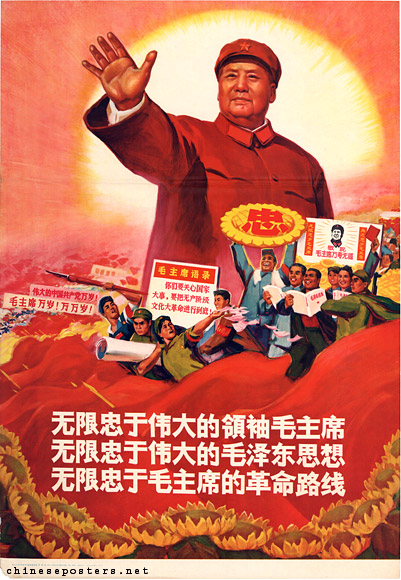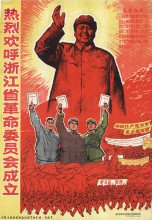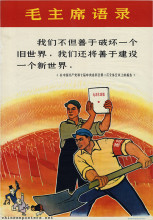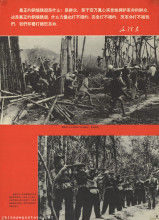Sailing the seas depends on the helmsman, waging revolution depends on Mao Zedong Thought, 1969
The Mao cult involved a lot of sloganeering that served to bolster the myth surrounding the Chairman and to ascribe super-human qualities to him. During the first reception of millions of Red Guards on Tiananmen Square on 18 August 1966, Chen Boda first used the slogan of the ‘Four Greats’, with which he termed Mao as the great teacher, the great leader, the great (or supreme) commander, and the great helmsman. The image of Mao as the great helmsman not only inspired poster designers, but gave birth to a song, "Sailing the seas depends on the helmsman, waging revolution depends on Mao Zedong Thought".
Sailing the seas depends on the helmsman, waging revolution depends on Mao Zedong Thought, 1969
Other slogans revolved around the people’s loyalty that Mao deserved. Particular mention must be made of the ‘Three Loyalties’, which called for boundless loyalty to Chairman Mao, loyalty to Mao Zedong Thought and loyalty to Chairman Mao’s revolutionary line. The Chinese character for loyalty, zhong (忠, visible on the sunflower below), played an important role in the images devoted to these slogans.
These and other slogans (‘The Four Boundlessness’, ‘Long Live ...’, ‘Eternal Life ...’) were shouted in public by leaders and led alike, used in the print media and wall papers, and became part of everyday speech.
Great teacher, Great leader, Great commander, Great helmsman - Long live chairman Mao, 1967
Guo Jian, Yongyi Song & Yuan Zhou, Historical Dictionary of the Chinese Cultural Revolution (Lanham: The Scarecrow Press, Inc., 2006)
Lu Xing, Rethoric of the Chinese Cultural Revolution - The Impact on Chinese Thought, Culture and Communication (Columbia: University of South Carolina Press, 2004)
Helmut Martin, Cult & Canon - The Origins and Development of State Maoism (Armonk: M.E. Sharpe Inc., 1982)
Melissa Schrift, Biography of a Chairman Mao Badge - The Creation and Mass Consumption of a Personality Cult (New Brunswick: Rutgers University Press, 2001)
Yan Jiaqi & Gao Gao (translated & edited by D.W.Y. Kwok), Turbulent Decade - A History of the Cultural Revolution (Honolulu: University of Hawai’i Press, 1996)























![It is now the spring plowing season […]](/sites/default/files/styles/medium/public/images/pc-1967-044.jpg?itok=ge9UyV6T)





























